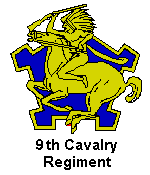

9th Cavalry Regiment
WW II, European Theater
"We Can, We Will"

![]()



![]()
|
|---|
![]() On 02 July 1942, due to overcrowding at Ft. Riley due to the massive build up
of the Army, the 9th Cavalry Regiment began movement from Ft. Riley to Texas,
by rail, arriving in Spoffard, TX on 03 July. The next day they set up
temporary field operations at Fort Clark, TX where it continued training for
combat in Europe. By 09 July arrangements for permanent barracks were made and
the 9th Cavalry relieved the 112th Cavalry Regiment so that the 112th could
take up continued training for combat and patrol duty along the Texas border.
The 9th and 27th Cavalry, active at the Texas post, eventually were reassigned
from the 4th Cavalry Brigade to the 5th Cavalry Brigade.
On 02 July 1942, due to overcrowding at Ft. Riley due to the massive build up
of the Army, the 9th Cavalry Regiment began movement from Ft. Riley to Texas,
by rail, arriving in Spoffard, TX on 03 July. The next day they set up
temporary field operations at Fort Clark, TX where it continued training for
combat in Europe. By 09 July arrangements for permanent barracks were made and
the 9th Cavalry relieved the 112th Cavalry Regiment so that the 112th could
take up continued training for combat and patrol duty along the Texas border.
The 9th and 27th Cavalry, active at the Texas post, eventually were reassigned
from the 4th Cavalry Brigade to the 5th Cavalry Brigade.
![]() However, it was not the destiny of the 9th Cavalry Regiment to take part in
World War II as a unit. The War Department decided that deployment of the 2nd
Cavalry Division was unnecessary for victory in Europe and directed the
Division deploy to the Mediterranean theater and inactivate its units to
provide replacements to critical logistical organizations. Consequently, The
9th Cavalry Regiment was directed to deploy to the Mediterranean theater and
inactivate so that replacement personnel and equipment could be provided to
critical logistical organizations that would back up the invasions of Italy
and Europe.
However, it was not the destiny of the 9th Cavalry Regiment to take part in
World War II as a unit. The War Department decided that deployment of the 2nd
Cavalry Division was unnecessary for victory in Europe and directed the
Division deploy to the Mediterranean theater and inactivate its units to
provide replacements to critical logistical organizations. Consequently, The
9th Cavalry Regiment was directed to deploy to the Mediterranean theater and
inactivate so that replacement personnel and equipment could be provided to
critical logistical organizations that would back up the invasions of Italy
and Europe.
|
|---|
![]() Following their arrival and staging, the 9th Cavalry Regiment was inactivated
on 07 March 1944. Personnel were transferred and reassigned to service units
and assets were transferred to the provisional port companies. This action
marked the end of an era "the horse cavalry regiments" in the United States
Army which were being replaced by mechanized units. The Cavalry Branch was
eventually merged with the armored units and renamed Armor Branch in 1950, as
a recognition of "a continuation of the cavalry".
Following their arrival and staging, the 9th Cavalry Regiment was inactivated
on 07 March 1944. Personnel were transferred and reassigned to service units
and assets were transferred to the provisional port companies. This action
marked the end of an era "the horse cavalry regiments" in the United States
Army which were being replaced by mechanized units. The Cavalry Branch was
eventually merged with the armored units and renamed Armor Branch in 1950, as
a recognition of "a continuation of the cavalry".
![]() Two subordinate units, 9th Reconnaissance Troop, 9th Infantry Division (later
consolidated with the 3rd Reconnaissance Squadron, 9th Cavalry Regiment on 01
December 1957.) that would later become part of the present 9th Cavalry
Regiment, carried out missions in the WW II European and Pacific Theaters of
Operations. The 9th Reconnaissance Troop, initially landed in North Africa and
fought their way through the Tunisian, Sicilian and Italian Campaigns. Later,
redesignated as the 9th Cavalry Reconnaissance Troop, (Mechanized), they
participated in the Normandy Invasion and fought their way through the Central
European Campaigns.
Two subordinate units, 9th Reconnaissance Troop, 9th Infantry Division (later
consolidated with the 3rd Reconnaissance Squadron, 9th Cavalry Regiment on 01
December 1957.) that would later become part of the present 9th Cavalry
Regiment, carried out missions in the WW II European and Pacific Theaters of
Operations. The 9th Reconnaissance Troop, initially landed in North Africa and
fought their way through the Tunisian, Sicilian and Italian Campaigns. Later,
redesignated as the 9th Cavalry Reconnaissance Troop, (Mechanized), they
participated in the Normandy Invasion and fought their way through the Central
European Campaigns.
![]()
Needs Data




 Need a gift for an Alumni of the 1st Cavalry Division? |
|---|


![]() eMail Your WebSite Comments.
eMail Your WebSite Comments.
![]()
![]()
![]() Return to "MyOwnPages"©.
Return to "MyOwnPages"©.
![]()
Revised 31 Jan '12 SpellChecked